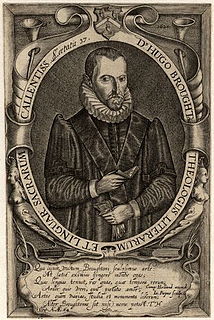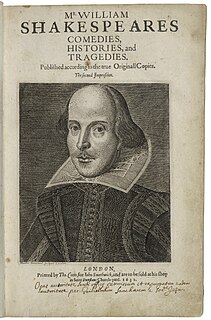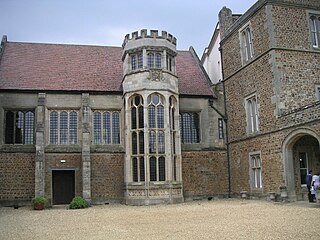
The Marprelate Controversy was a war of pamphlets waged in England and Wales in 1588 and 1589, between a puritan writer who employed the pseudonym Martin Marprelate, and defenders of the Established Church.

Hugh Broughton was an English scholar and theologian.

The Second Folio is the 1632 edition of the collected plays of William Shakespeare. It follows the First Folio of 1623. Much language was updated in the Second Folio and there are almost 1,700 changes.

Henry Lyte was an English botanist and antiquary. He is best known for two works, A niewe Herball (1578), which was a translation of the Cruydeboeck of Rembert Dodoens, and an antiquarian volume, The Light of Britayne (1588), both of which are dedicated to Queen Elizabeth I.
Job Throckmorton (Throkmorton) (1545–1601) was an English religious pamphleteer and Member of Parliament. Possibly with John Penry and John Udall, he authored the Martin Marprelate anonymous anti-clerical satires; scholarly consensus now makes him the main author.
Robert Some (Soame) (1542–1609) was an English churchman and academic. Master of Peterhouse, Cambridge from 1589, Some played a prominent part in the ecclesiastical controversies of his time, taking a middle course, hostile alike to extreme Puritans and Anglicans.
John Wolfe was an English bookseller and printer. His considerable ambition and his disdain for the printing patent system of Elizabethan England drew the ire of his competitors and authorities in his early career. After being jailed twice and having his printing materials seized, Wolfe transformed himself into an ardent defender of printing privileges. By 1593, he was appointed Printer to the City of London.
Thomas White (c.1550–1624) was an English clergyman, founder of Sion College, London, and of White's professorship of moral philosophy at the University of Oxford. Thomas Fuller in Worthies of England acquits him of being a pluralist or usurer; he made a number of other bequests, and was noted in his lifetime for charitable gifts.

Pasquill is the pseudonym adopted by a defender of the Anglican hierarchy in an English political and theological controversy of the 1580s known as the "Marprelate controversy" after "Martin Marprelate", the nom de plume of a Puritan critic of the Anglican establishment. The names of Pasquill and his friend "Marforius", with whom he has a dialogue in the second of the tracts issued in his name, are derived from those of "Pasquino" and "Marforio", the two most famous of the talking statues of Rome, where from the early 16th century on it was customary to paste up anonymous notes or verses commenting on current affairs and scandals.
John Udall (1560?–1592) was an English clergyman of Puritan views, closely associated with the publication of the Martin Marprelate tracts, and prosecuted for controversial works of a similar polemical nature. He has been called "one of the most fluent and learned of puritan controversialists".
Timothie Bright, M.D. (1551?–1615) was an Early Modern English physician and clergyman, the inventor of modern shorthand.
John Farmery, M.D. was an English physician.

William Rogers was an English engraver. A Citizen of the City of London – one of his surviving engravings is signed Anglus et Civis Lond(oniensis). – he is the first English craftsman known to have practised engraving and the greatest portrait engraver of the Tudor period. The English were extremely late in coming to printmaking, though several artists from the thriving Flemish industry had worked in England already; the engraved print had been invented over 150 years before Rogers began to produce them. Rogers was also a goldsmith, and presumably acquired his technique in that context. His portrait style reflects Flemish models, while his backgrounds are often "overloaded with ornament" that is "redolent of the goldsmith's shop".
John Hammond (1542–1589) was an English civil lawyer and politician.

Robert Waldegrave or Walgrave, the son of Richard Waldegrave of Blockley, Worcestershire, was a 16th-century printer and publisher in England and Scotland. From 1578 to 1588 he printed numerous, mainly religious works in London, and from 1590 to 1603, more than 100 books in Scotland. In 1603, following King James I of England's accession to the English throne, he returned to England, but died later the same year.

John Hales was the owner of the Whitefriars in Coventry at which two of the Marprelate tracts were printed on a secret press. He was the nephew and heir of John Hales, Clerk of the Hanaper, and the nephew of Sir Thomas Lucy of Charlecote.
George Turner was an English physician in London. He is known for his interest in alchemy and friendship with Simon Forman. His wife was the convicted murderer Anne Turner.
Elizabeth Hussey, later Elizabeth Crane and Elizabeth Carleton, was a religious activist with strong Puritan sympathies. She and her second husband, George Carleton, were prosecuted for involvement in the Marprelate controversy. The first of the anonymous Marprelate tracts, Martin's Epistle, was printed at her home in East Molesey, Surrey, in October 1588.
Andrew Simson (c.1526–c.1591) was a Scottish minister and schoolmaster.
The public domain consists of all the creative work to which no exclusive intellectual property rights apply. Those rights may have expired, been forfeited, expressly waived, or may be inapplicable.

Sir Sidney Lee was an English biographer, writer and critic.

The Dictionary of National Biography (DNB) is a standard work of reference on notable figures from British history, published since 1885. The updated Oxford Dictionary of National Biography (ODNB) was published on 23 September 2004 in 60 volumes and online, with 50,113 biographical articles covering 54,922 lives.









